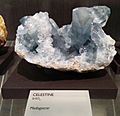Celestine (mineral) facts for kids
Celestine is a beautiful blue mineral. It is also known as celestite. This mineral is the main source of the element strontium. Celestine is made of strontium sulfate (SrSO4). Strontium is used in fireworks and in some metal alloys.
Contents
What is Celestine?
Celestine is a mineral that often forms lovely crystals. Its name comes from the Latin word caelestis, meaning "heavenly" or "celestial." This name fits well because celestine often has a soft, sky-blue color.
How Celestine Forms
Celestine usually forms in sedimentary rocks. These are rocks made from layers of sand, mud, and other materials. It often grows in places where water has evaporated, leaving behind minerals. This process is called evaporation.
Celestine can also be found in geodes. A geode is a hollow rock that has crystals growing inside it. Imagine a rock that looks ordinary on the outside, but when you crack it open, it's filled with sparkling blue crystals!
Where is Celestine Found?
Celestine is found in many places around the world. Some of the most famous locations include:
- Madagascar, known for its large, beautiful celestine geodes.
- Ohio, USA, where you can find the "Crystal Cave" filled with celestine crystals.
- Poland, which has important mining areas for celestine.
- Other countries like the United Kingdom, Germany, and Canada also have celestine deposits.
Uses of Strontium from Celestine
Celestine is important because it is the main source of the element strontium. Strontium is a silvery-white metal. It has several interesting uses:
Fireworks and Flares
One of the most exciting uses for strontium is in fireworks. When strontium compounds are burned, they produce a bright, vivid red color. This is why many red fireworks get their color from strontium. It is also used in signal flares to create a strong red light.
Other Uses of Strontium
Strontium is also used in other ways:
- Alloys: It can be mixed with other metals to create stronger alloys. An alloy is a mixture of two or more metals.
- Glass: Strontium is sometimes added to glass for things like television screens. It helps block X-rays.
- Magnets: Strontium can be used to make special types of magnets.
- Medicine: In some medical treatments, strontium is used, especially in bone health research.
Properties of Celestine
Celestine has several unique properties that help scientists identify it:
- Color: It is usually pale blue, but can also be white, gray, or even reddish.
- Hardness: On the Mohs scale of mineral hardness, celestine is a 3 to 3.5. This means it is a relatively soft mineral. You could scratch it with a copper coin.
- Luster: It has a glassy or pearly shine.
- Crystal Shape: Celestine crystals often form flat, tablet-like shapes or long, slender prisms.
Luminescence
Some celestine samples can show luminescence. This means they can glow under certain conditions. For example, they might glow when exposed to ultraviolet (UV) light. This glow is often a pale blue or white color.
Images for kids
-
Celestine mineral on display at Yale's Peabody Museum
See also
 In Spanish: Celestina (mineral) para niños
In Spanish: Celestina (mineral) para niños






